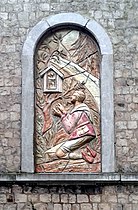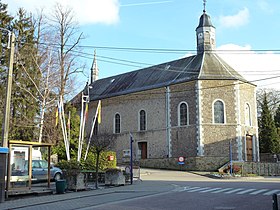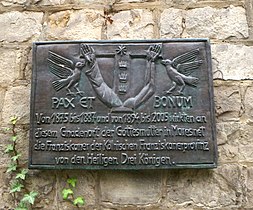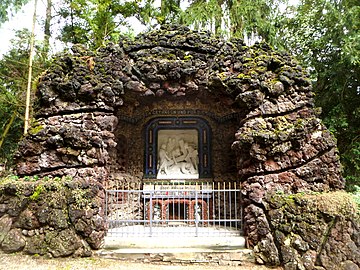Sanctuary of the Moresnet Chapelle

The pilgrimage site Moresnet-Chapelle ([ mɔ.ʁɛs.nɛt ], ndl . : "Eiksken", popularly also "Eichschen", synonymous for "little oak") is a place of Marian veneration in Moresnet-Chapelle , a district of Plombières in the Walloon Region of the Province of Liege in Belgium . It consists of the Chapel of Mercy , a pilgrimage church and the park-like Kalvarienberg ( Calvaire ) with the Way of the Cross .
From the 1870s until the end of 2005, this pilgrimage site was looked after by Franciscans , and since 2014 by the Community of Crucified and Risen Love . The pilgrimage site has developed into a well-known place of pilgrimage that is visited by around 150,000 visitors every year. Since 1863, numerous pilgrims , especially from Aachen, have been coming to Moresnet on foot through the Aachen forest every Wednesday . Furthermore, there is an old hermitage and the Maria Monastery , Help of Christians with the pilgrims office.
history
The veneration of Mary goes back to an event that is said to have occurred in Moresnet in the middle of the 18th century. Peter Arnold Frank (1741–1801) apparently suffered from epilepsy . He had his first epileptic seizure during an earthquake that broke out in this area around 1747. The pious parents then visited the Aachen Shrine Tour with their son in 1748 , where they hoped to heal him through the veneration of the relics there . However, since the seizures did not subside, Peter Arnold asked a messenger woman from the village to bring him a statue of Mary from Aachen on occasion. This wish was granted to him in 1750 and he made a wayside shrine especially for it . He attached this to an old oak tree in the nearby forest, where he could be undisturbed while praying. Over the years the epileptic seizures subsided, which Peter Arnold attributed to the invocation of the Blessed Mother.
Word of this incident quickly got around in the village and many came to be relieved of their suffering. During the French Revolution , Peter Arnold hid the miraculous image in his house. When he wanted to bring the figure back after the end of the turmoil of the revolution, the box in which he had hidden it was empty for some unknown reason. Instead, according to tradition, he found the image of the Virgin "miraculously" restored to its original place on the old oak.
The veneration of the miraculous image deepened when in the years 1771 and 1797 a rampant cattle epidemic was averted from the place after the farmers had made pilgrimages to the miraculous image. Since the pilgrimages have taken place with a certain regularity and with steadily increasing numbers of pilgrims since then, the year 1797 can be regarded as the actual beginning of the pilgrimage site Moresnet-Chapelle.
After the death of Peter Arnold in 1801, the citizens of Moresnet founded a committee to build a stone chapel on the site of the old oak, which was inaugurated in 1823 and in which the miraculous image found a permanent home. In 1829 the parish of St. Jakob in Aachen organized a pilgrimage for the first time , and parishes from Belgium and the Netherlands followed suit. With the consecration of the meanwhile enlarged chapel in 1831 the church recognition of Moresnet-Chapelle as a place of pilgrimage took place. A hermit , who had settled next to the chapel in the same year and built a hermitage there, looked after the chapel and the pilgrims. More hermits took care of the pilgrimage site until 1876, the last one to date to join the Franciscan order.
The monastery
The Franciscans of the Saxon order province of Saxonia had settled in Moresnet through the mediation of the Aachen order founder Franziska Schervier after they had to leave Prussia as a result of the culture war . The brothers in Moresnet came from the residence in Aachen , which was closed on September 15, 1875. Because of the German language in the Moresnet area, there were no language barriers. The bishop of Liège, Théodore de Montpellier , after lengthy negotiations and through the mediation of the Aachen citizen von Carlowitz, a relative of the bishop, commissioned the order to look after the pilgrimage site on May 1, 1878; The local clergy of Moresnet had initially resisted taking over the pilgrimage pastoral care.
With further increasing number of pilgrims to the chapel of the building was realized a pilgrimage church instead that on September 8, 1880 ordained was. Five years later the foundation stone was laid for the construction of a convent building for the Franciscans in the immediate vicinity of the church, which was placed under the patronage of Mary, Help of Christians . At first the brothers lived in a small house, of which they converted two of the eight rooms into a house chapel. The Franciscans raised the funds through collections in Aachen. Father Othmar Maasmann, who was repeatedly Provincial Minister of the Order of Saxonia between 1861 and 1864, had a decisive influence ; from 1875 to 1879 and again from 1885 to 1887 he served as superior ( president ) of the monastery in Moresnet and built the church and monastery. The acquisition of the property and the construction of the church and monastery were made possible by Aachen benefactors. Formally - because of the Franciscans' vow of poverty - the Aachen citizen Wilhelm Joseph Dahmen bought the property in Moresnet and, with papal permission, signed it over to Father Othmar Maasmann as superior in 1882; In order to prevent the monastery from falling to his secular heirs in the event of his death, Maasmann appointed the Franciscan Theodor Raitz von Frenz as the beneficiary in his will. After the Franciscans were allowed to return to Prussia in accordance with the law of April 29, 1887, they returned to Aachen in 1888, where Othmar Maasmann was superior until 1891 and also built a new monastery with a church in Monheimsallee. Thereupon the Jesuits temporarily took over an order, which was still forbidden in Prussia, and took care of the pilgrimage site; the buildings were rented to them by the Franciscans. The Jesuits left the place as early as 1894 and the Franciscans returned on September 1, 1894. The first thing they did was create a Calvary with the Way of the Cross .
After the First World War , the monastery was confiscated by the Belgian government in 1919. At the instigation of the political community of Moresnet, however, the administration of the building remained with the Franciscans until it was released in 1921. In 1921 a solemn procession with the miraculous image could take place again.
The Cologne Franciscan Province of the Three Wise Men, which was revived in 1929 and which the convent in Moresnet joined, looked after the pilgrimage site until 2005. After the Order Province could no longer guarantee the work due to a lack of offspring, responsibility for the facilities was initially transferred to the parish. From 2014 the Community of Crucified and Risen Love, a private association of believers from Maastricht in the Netherlands, founded a branch there and took over the care of the pilgrimage. In memory of the initiator of the pilgrimage site, Peter Arnold Frank, the square in front of the church was renamed “Place Arnold Frank” by the community of Plombières.
Pilgrimage
The pilgrimage route from Aachen to Moresnet-Chapelle and the place of pilgrimage are part of the Way of St. James , which as "Route 1" of the North Rhine-Westphalia Way of St. James leads from Beyenburg via Cologne and Aachen to Liège . Even in the earliest times, the Church of St. Jakob was the first station church after Aachen Cathedral on the so-called Niederstraße from Aachen to Santiago de Compostela and whoever stopped there received the travel blessing and left the pilgrimage city of Aachen through the former Jakobstor . This procession was also used by smugglers and during the first years of the Nazi era also by Jewish citizens who tried to find shelter in Belgium or to leave the area of influence of the Nazis entirely. French and Walloons who escaped from captivity also used this route. As a pilgrimage chaplain , Father Bentivolius Marxen was the contact person for these people there.
To date, hardly anything has changed in the course of the route and after leaving the St. James' Church, the pilgrimage route runs along Lütticher Straße to the Preusweg . At the end of this street, at the corner of Karlshöher Talweg , where the Wednesday pilgrims meet in a parking lot , the pilgrim path continues in a south-westerly direction over the Moresneter Weg through the Aachen forest, crosses the green border to Belgium and continues to the railway underpass Moresnet-Chapelle, where he moves as Rue d'Aix to the pilgrimage chapel. The length of the pilgrimage route is between six and eight kilometers, depending on whether you start from the Jakobskirche or the Preusweg. There are five pilgrim crosses on the German side and eight on the Belgian side, some with message boards, donated by the Aachen pilgrims . Among other things, they commemorate the horrors of the wars and the fallen as well as the deceased, including in particular Therese Göttgens and Helene Sommer, who died on the pilgrimage in 1937 and 1998, respectively.
Chapel of Mercy
After the pilgrimage site had steadily increased in popularity at the beginning of the 19th century, a citizens' association decided to build a stone chapel on the spot where the oak with the miraculous image was located. This was consecrated in 1823 and had to be extended by a few meters and two window widths for the first time in 1830 due to the large crowd. A second extension followed in 1873, based on the octagon at Aachen Cathedral , the Liebfrauenbasilika in Scherpenheuvel-Zichem and the Gnadenkapelle in Kevelaer in the form of an octagonal porch. After the Franciscans took over the pilgrimage sites in 1876, three years later they tore down the original parts of the building of the old Chapel of Grace, except for the newer octagon, and added today's pilgrimage church to it.
The chapel with the miraculous image thus became a side altar in the church choir . In order not to disturb the pilgrimage services by visitors to the image of grace, the Franciscans decided towards the end of the 20th century to build a separate new chapel of grace on the south side of the church. This extension was rebuilt in the years 1991/1992 according to plans by Luc Lebeau and Manfred Lerho from Kelmis in an octagonal shape on the side of the nave and made accessible through doors set into the side wall of the choir and from the outside through a separate corridor along the choir. A light dome in the ceiling and a large round window above and two narrow longitudinal windows next to the altar of grace provide the lighting. The German-Dutch artist Frans Griesenbrock was responsible for planning and creating the windows . The foundation stone of the chapel was laid on February 2, 1991, the inauguration was on September 8, 1991 and the transfer of the miraculous image on February 2, 1992.
The central focal point of the new chapel is the neo-Gothic altar of grace on the south wall, flanked by two additional side walls with niches for burning votive candles . In the raised middle section of the altar, a valuable shrine is embedded in an open wooden case, which was made in the Aachen goldsmith's workshop by Johann Schreyer (1855–1935). In this is the terracotta figure of the Mother of God from 1750 with the baby Jesus standing on a baroque column . The figure of the Virgin, which is dressed in a long brown dress and decorated with a blue stole, like the figure of the baby Jesus, can be adorned with various jewelry and fabrics made of silk embroidery on certain festive days.
The historical occasions of the pilgrimage, such as the attachment of the statue of Mary to the oak by the pious Peter Arnold Frank and the cows recovered from the epidemic, are depicted in the wooden relief of the altar below the miraculous image. On the side of the shrine, gilded panels embedded in the wood show incidents from the life of Mary.
Pilgrimage church
The laying of the foundation stone for the new pilgrimage church commissioned by the Franciscans took place on June 13, 1879 and, after the old Chapel of Mercy was demolished, it was added to the east of the octagon built in 1873 and consecrated on September 8, 1880. It was not until 1924 that the octagon, which until then had only been loosely leaned against the nave, was continuously connected to the choir and opened so that a common room was created. The octagon has served as the main entrance ever since. In 1937, as part of a thorough restoration, the simple and elongated nave was raised by six rows of stones in order to achieve a uniform roof overlay. The walls were reinforced by a belt cornice running all around , above which a total of 15 arched windows are let in at regular intervals , which were renewed in 1950 by the glass painter Frans Griesenbrock. The walled-up arched window behind the altar in the apse has a relief on the outside , which was also made by Griesenbrock and depicts the praying Peter Arnold Frank in front of the miraculous image on the oak. On the octagon one tipped with a cross are skylights for a bell and the church clock and on the roof of the apse placed a turret with a replica of the miraculous image of another bell, both of which were donated in 1900's.
The interior of the church ends in five yokes with ribbed vaults , in whose keystones the Marian monogram "M" is embedded. The organ stage is located above the main entrance of the octagon with a view of the apse in the east of the nave with the high altar and the celebration altar . The high cross is flanked by statues of the Virgin Mary and the Apostle John . In addition, on the sides of the chancel there is a portrait of Mary with the baby Jesus and a statue of St. Anthony of Padua .
On the north wall of the choir there are stations of the cross in the style of the Nazarenes and an expressive Pietà , on the south wall there are statues of hll. Francis , Clare , Anthony of Padua and Joseph . In addition, both side walls are covered with numerous pilgrim votive tablets.
In the central aisle of the church there is a plate in the floor that indicates the location of the earlier oak on which the image of grace attached by Peter Arnold Frank hung from 1750 to 1823.
The praying Peter Arnold Frank; Relief by Frans Griesenbrock
Way of the Cross
Immediately after their return to Moresnet in 1894, the Franciscans, on the initiative of their President Johannes Ruiter, made the decision to build a Way of the Cross. With the support of the community, the praeses acquired neighboring land and began planning the financing and construction. The implementation was delayed by illness, and it was only through his brother Quintilian Borren that the work could be completed by early 1904.
Borren had built 14 large stations in the manner of a grotto Belgian rubble created and outside with lava stones and inside with stalactites were coated on the ceilings and decorated with wrought iron railings. The inner back walls are lined like a mosaic with many details. The 14 stations of the Cross, created as high reliefs, were created by the Cologne sculptor Wilhelm Albermann from French sandstone. The last to be built in 1904 was the XIV Station, the Entombment of Jesus.
The XII. Station, the crucifixion of Christ , which was designed as a Calvary with space for outdoor worship. While all the relief pictures had the size of 150 × 120 cm, the high relief in the grotto of the XII. Station in the size of 200 × 220 cm and represents a crucifixion group with St. Francis. In 1903 the representations of Mary and the Apostle John, the crosses of the thieves and the captain were added, which were designed by the Aachen sculptor Lambert Piedboeuf and placed three meters above the grotto. An altar was erected in front of the grotto and benches were set up for pilgrimage services. Since the figure of Christ and the figures of the two thieves were badly weathered, they were replaced in 1981 by bronze sculptures based on designs by the Franciscan and artist Laurentius Ulrich Englisch . The park-like Way of the Cross is surrounded all around by a half-height wall, in which the gates on the side of the monastery are provided with richly decorated wrought iron bars.
Well-known Franciscans
- Thaddäus Soiron , theologian and university professor, last lived in the convent in Moresnet and is buried in the Franciscan cemetery at the foot of the Calvaire .
- Bentivolius Marxen , pilgrimage pastor and refugee helper during the Nazi era, also buried in the Franciscan cemetery.
literature
- Ingeborg Pühringer and Bernardin Schröder: Moresnet-Chapelle: The Calvary of Moresnet-Chapelle , Art Publishing House Peda; Passau 1998 ISBN 978-3-8964-3083-0
- Franciscan Convent Moresnet: Marian pilgrimage site Moresnet-Chapelle , Little Art Guide No. 2087; Schnell & Steiner, Regensburg 1997 ISBN 978-3-7954-5818-8
Web links
- Moresnet-Chapelle pilgrimage website
- The Calvary Cemetery , on trois-frontieres.be
- Popular excursion destinations in the province of Liège: Moresnet-Chapelle Marian pilgrimage site , on BRF-Nachrichten of August 24, 2016 (with audio contribution)
- Brief description on Grenzrouten.de
- The Franciscan monks in Moresnet Chapel - Father Johannes Ruiter, founder of the Way of the Cross in Moresnet Chapel , on trois-frontieres.be
- Martin Thull: How Moresnet became a magnet for pilgrims , in Aachener Zeitung on June 16, 2014
Individual evidence
- ↑ Apollinari Church in Remagen
- ^ Place of pilgrimage Moresnet-Chapelle: history
- ↑ Dieter Berg (Ed.): Traces of Franciscan History . Werl 1999, pp. 492-503
- ↑ Hans-Georg Aschoff : From the Kulturkampf to the First World War. In: Joachim Schmiedl (Ed.): From Kulturkampf to the beginning of the 21st century. Paderborn 2010, pp. 23–287, here p. 57 (construction), p. 97 (ownership), 153, 157, 246.
- ^ Gerhard Lindemann : From the November Revolution to the Second Vatican Council (1918–1962). In: Joachim Schmiedl (Ed.): From Kulturkampf to the beginning of the 21st century. (= History of the Saxon Franciscan Province , Vol. 3) Paderborn 2010, pp. 289–631, here p. 296.
- ↑ On the history of the Cologne Franciscan Province ( Memento of the original from March 23, 2017 in the Internet Archive ) Info: The archive link was inserted automatically and has not yet been checked. Please check the original and archive link according to the instructions and then remove this notice. , Anniversary exhibition in the Diocesan Library Cologne 2004
- ^ North Rhine-Westphalian Way of St. James
- ↑ Herbert Ruland Netty Drooghaag from Gemmenich on GrenzGeschichteDG
- ^ Franciscan convent Moresnet: Marian pilgrimage site Moresnet-Chapelle, p. 8
- ↑ Postcard of the pilgrimage church in front of the roof leveling
- ^ Franciscan convent Moresnet: Marian pilgrimage site Moresnet-Chapelle , p. 8
- ↑ Way of the Cross Moresnet on karmatan.de
Coordinates: 50 ° 43 ′ 51.1 ″ N , 5 ° 59 ′ 47 ″ E











